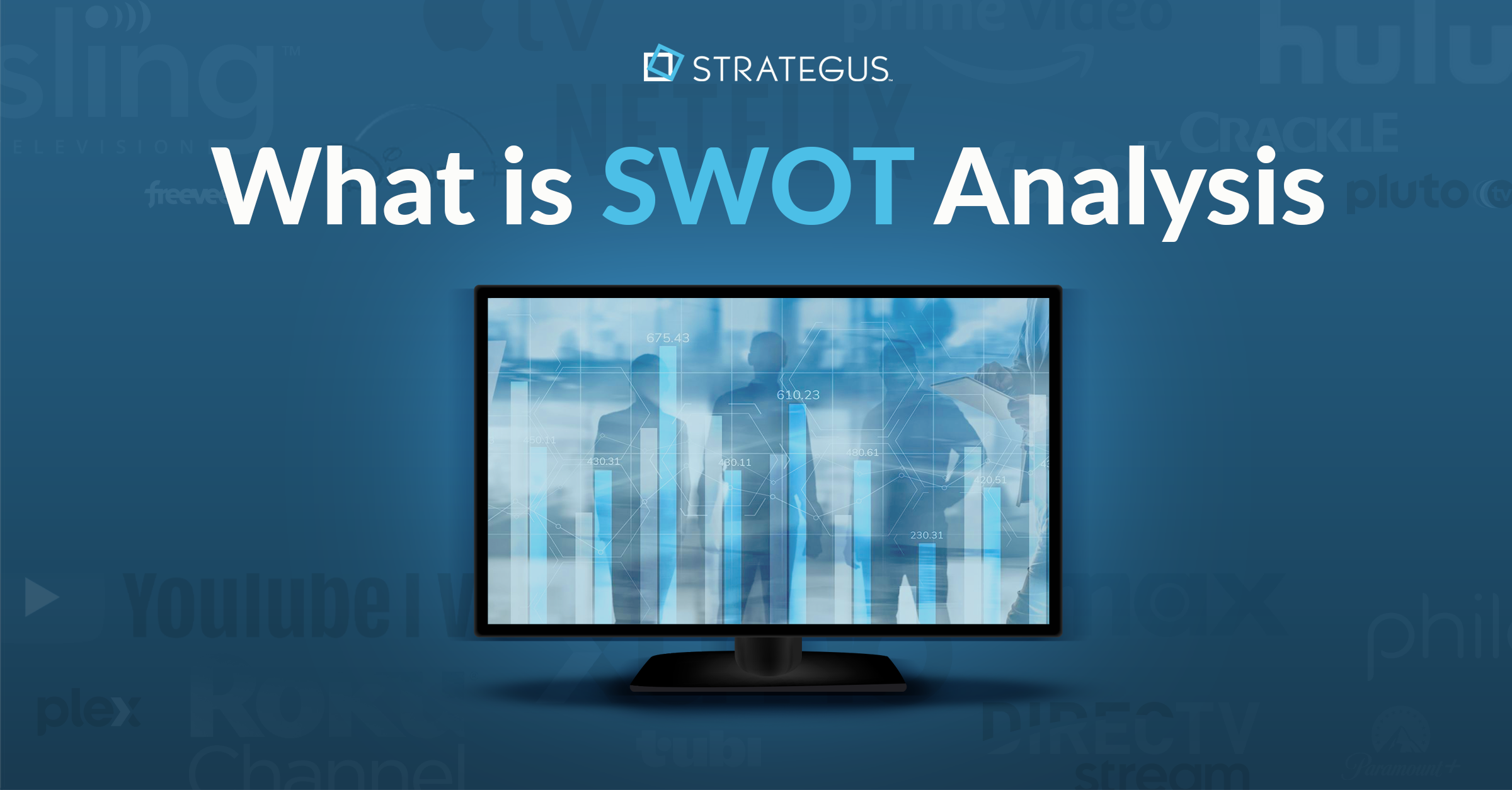- Home
- Strategus Blog
- What is SWOT Analysis: Benefits, Examples & How to Do It
What is SWOT Analysis: Benefits, Examples & How to Do It
 Andy Dixon
Andy Dixon
15 minutes read

Feeling like your marketing efforts aren’t hitting the mark?
A SWOT analysis helps you cut through the noise by identifying what’s working, what’s broken, and where the real growth potential lies.
In this article, you’ll learn how to use SWOT to build a smarter, sharper marketing game plan.
What Is a SWOT Analysis?
A SWOT analysis is a strategic framework that helps businesses evaluate their Strengths, Weaknesses, Opportunities, and Threats. It creates a clear snapshot of where your brand stands internally and how external factors might affect your success.
- Strengths: Internal capabilities, resources, or assets that give your marketing strategy an edge
- Weaknesses: Internal limitations that hold back performance or growth
- Opportunities: External trends or gaps in the market you can leverage
- Threats: External risks that may hurt your performance or market position
How DOES a SWOT Analysis Work?
Imagine you are building a marketing campaign for a local, independent bakery/coffee shop, intending to increase breakfast traffic and compete against nearby national chain restaurants.
Based on that, here’s a SWOT analysis model example:
- Strengths: Talented bakers with innovative creations using local ingredients; location within walking distance of several large office buildings– long history in the community
- Weaknesses: Small advertising budget– limited resources
- Opportunities: Fall and holidays are coming soon– locally sourced and sustainable ingredients are favored
- Threats: Within walking distance of two or more national chains– increasing prices of ingredients
Why Is SWOT Analysis Important for Smarter Marketing Decisions
Marketing is full of noise: trends, buzzwords, new tools, and constant pressure to launch. Without clear direction, strategies often rely on gut instinct or what worked last year.
A SWOT analysis cuts through that chaos by giving you a structured, objective look at your business and the market you’re in.
1. Get Clarity Before You Spend
A SWOT analysis helps you step back and ask:
- What do we actually do well?
- What’s holding us back?
- Where is the market opening up?
- What risks could blindside us?
Instead of launching generic campaigns or copying competitors, you’ll know exactly where to invest your time, budget, and energy.
2. Make Smarter, Faster, More Targeted Decisions
With SWOT, you:
- Anticipate challenges before they hit your ROI
- Align marketing with real business goals instead of chasing shiny objects
- Target the right audience based on both internal capabilities and market demand
- Avoid waste by dropping low-impact ideas early
It’s not just about identifying strengths or threats—it’s about building a roadmap that adapts to change while staying rooted in reality.
3. From Strategy to Execution
Whether you’re launching a new product, repositioning your brand, or planning next quarter’s budget, SWOT helps you:
- Prioritize what matters
- Avoid common pitfalls
- Design campaigns with purpose
Instead of reacting to every shift in the market, you’re proactively shaping your path with clarity, confidence, and control.
How to Conduct SWOT Analysis for Marketing & Advertising
A SWOT analysis only works if you approach it strategically, not just as a checklist.
Here's a step-by-step guide to doing it right, with marketing-specific context, examples, and tips for applying your insights directly to campaigns and decision-making.
1. Gather the Right People
Marketing doesn't exist in a vacuum. Sales can tell you what prospects are saying. Customer support can highlight frequent complaints. Product teams know what's coming next. Leadership can share broader goals.
Start by bringing together key stakeholders from marketing, sales, customer service, product, and leadership. This ensures that your SWOT analysis reflects real-world inputs, not assumptions.
Here’s an action plan you can follow:
- Set up a 60-minute workshop.
- Share your goals ahead of time.
- Ask each person to come with 3 strengths, weaknesses, opportunities, and threats based on their function.
2. Set Up the SWOT Matrix
Use a 2x2 grid to keep things organized. Keep it visual and collaborative. Use a digital whiteboard or shared doc.
|
Internal (You control) |
External (You don’t control) |
|
|
Positive impact |
Strengths |
Opportunities |
|
Negative impact |
Weaknesses |
Threats |
Create a shared document or whiteboard tool (like Miro or Google Slides) and label each quadrant. This becomes the workspace for your analysis.
3. Audit Internal Factors (Strengths & Weaknesses)
Start with what your marketing team and business can control directly. These are internal factors that influence your success or failure.
- Strengths: These are your competitive marketing advantages.
Examples:
- Strong brand reputation in your industry
- High-performing content or SEO rankings
- Skilled, experienced marketing team
- Large engaged email list
- Loyal customer base that advocates for your brand
Use analytics to back these up. Check what channels drive the most conversions, which pages perform best, and where you outperform competitors.
- Weaknesses: These are gaps or limitations in your current marketing.
Examples:
- Poor social media engagement
- Limited marketing budget
- Low brand awareness in new regions
- High bounce rates or low conversion rates on key pages
- No clear differentiation from competitors
Pull real data. Look at cost-per-lead, customer feedback, churn rate, and competitor messaging. Don’t rely on gut feelings.
4. Analyze External Factors (Opportunities & Threats)
Now look at what’s happening in the market, industry, or audience behavior. These are things you don’t control—but can prepare for.
- Opportunities: Trends, gaps, or changes you can use to your advantage.
Examples:
- Competitors pulling back on ads
- New channels gaining popularity (like TikTok or Threads)
- High search interest in new product categories
- Untapped audience segments
- Shifts in consumer values (e.g., eco-consciousness)
Use tools like Google Trends, industry reports, and competitor analysis to validate these. Ask: What are people craving that we’re not yet offering?
- Threats: External risks that could limit or disrupt your strategy.
Examples:
- Changing algorithms that affect reach or ranking
- New competitors with better pricing or features
- Regulatory changes (e.g., data privacy laws)
- Platform dependency (e.g., too reliant on Facebook Ads)
- Economic downturns affecting buyer behavior
Review market forecasts, news alerts, and what customers are worried about in reviews or support tickets.
5. Prioritize Key Insights
Not every item in each quadrant is equally urgent or important. You need to rank your findings based on impact and urgency.
- High-impact strengths = things to double down on
- Critical weaknesses = blockers that need fixing fast
- Time-sensitive opportunities = trends you can act on before competitors
- Major threats = external risks that need a plan B
Assign scores (1–5) for potential impact. Focus on the top 2–3 in each quadrant. These become your strategic pillars.
From SWOT to Strategy: How to Build Campaigns From Your Analysis
A SWOT analysis is only useful if it translates into action. Too many businesses stop at identifying strengths, weaknesses, opportunities, and threats, then go back to generic campaigns.
To avoid that, you need to pair internal and external insights to design focused, high-impact strategies.
Below are four core combinations you can use to move from diagnosis to execution:
1. Strengths + Opportunities: Double Down on What Works
Use your existing strengths to capitalize on external opportunities. This is the fastest route to results because you're leveraging what you're already good at in a market that’s ready for it.
Example: You own a local café near office buildings (strength) and the holiday season is coming (opportunity). Launch a corporate catering campaign with pre-order incentives and office delivery.
How to Apply:
- Identify your top-performing channels or content themes
- Match them with market trends, timing windows, or emerging demand
- Create focused campaigns that amplify proven value in a receptive market
2. Weaknesses + Opportunities: Use the Market to Fix Gaps
This pairing helps you use external opportunities to work around or fix internal weaknesses. Instead of waiting to build capacity, you use timing, partnerships, or tools to fill the gap.
Example: You have a limited ad budget (weakness) but growing demand for healthy breakfast options (opportunity). Offer free samples and run referral campaigns through office admins and WhatsApp groups.
How to Apply:
- Identify low-cost channels (e.g. organic social, influencers, co-marketing)
- Create “scrappy” campaigns aligned with audience demand
- Use tools or temporary offers to fill capability gaps while building for scale
3. Strengths + Threats: Defend What You've Built
Here, your focus is on using your strengths to protect your business from external risks—be it competitors, regulations, or platform changes.
Example: Your brand has a loyal customer base and strong reviews (strengths), but a large competitor just opened across the street (threat). Launch a “Support Local” campaign highlighting your community roots and personal service.
How to Apply:
- Reinforce customer trust through transparency and consistency
- Differentiate based on your strengths (values, service, speed, customization)
- Use loyalty programs, exclusivity, or brand story to lock in customer preference
4. Weaknesses + Threats: Minimize Damage and Stay Resilient
This is your risk management zone. Combine your known weaknesses with market threats to create preventive strategies that reduce exposure and long-term impact.
Example: Your brand awareness is low (weakness), and national chains are expanding in your area (threat). Start showing up at local fairs, collaborate with community groups, and boost your presence through events and partnerships.
How to Apply:
- Don’t try to outspend or outscale—outmaneuver with local relevance
- Look for free or low-cost visibility channels (events, local media, partnerships)
- Strengthen the weakest points first (e.g., SEO, listings, reviews, retention)
Practical Next Step
Once you’ve identified the best combinations:
- Select 1–2 priority strategies per quarter
- Align them with team capabilities and budget
- Build campaigns that tie specific SWOT insights to tactical goals
- Track performance using metrics mapped to each quadrant (e.g., retention for strengths, reach for opportunities)
This approach turns your SWOT from a theoretical exercise into a direct planning tool.
Instead of working from assumptions or hype, you're designing campaigns that reflect your reality—and that’s where smart marketing begins.
Integrating SWOT Analysis with Market Segmentation
To go even deeper, combine SWOT analysis with market segmentation. Segmentation breaks your market into distinct audience groups based on needs, preferences, or behaviors.
When used together, SWOT and segmentation let you match the right message to the right audience, based on real strengths and market insights.
Example 1: New Health Food Product
Imagine you’re launching a new health food brand. You identify two potential segments:
- Segment A: Health-conscious adults
- Segment B: Early adopters seeking innovative food products
With SWOT analysis:
- For Segment A, you highlight strengths like all-natural ingredients, low-calorie recipes, and clean-label packaging.
- For Segment B, you lean into opportunities like being first-to-market or addressing a unique dietary need.
Result: Your messaging, product positioning, and channel strategy become personalized and precise.
Example 2: Restaurant SWOT and Segmentation Strategy
Let’s say a restaurant identifies a growing interest in clean eating:
- SWOT reveals: Strengths in fresh, organic ingredients; weakness in brand awareness; opportunity in rising health trends; threat from larger, chain restaurants.
- Market segmentation reveals: A local group of gym-goers and wellness-focused professionals.
Strategy:
- Create a campaign highlighting macro-friendly meals using real customer stories.
- Partner with fitness centers nearby.
- Use organic social and referral programs to grow reach without heavy spend.
This approach combines internal capabilities with market demand—resulting in high-impact, low-waste campaigns.
Marketing Plan Examples with SWOT Analysis
A SWOT analysis becomes truly valuable when it directly shapes your marketing plan. Below are three real-world examples showing how different types of businesses can use SWOT insights to guide their strategy.
Each example ties the SWOT findings to clear, targeted actions—so you can see how to move from analysis to execution.
Example 1: E-commerce Brand Launching a New Product Line
Business Goal: Launch a new eco-friendly skincare line targeting Gen Z.
SWOT Analysis:
|
Category |
Details |
|
Strengths |
- Loyal customer base from previous product lines - Strong Instagram following with high engagement |
|
Weaknesses |
- Low email open rates - No influencer partnerships yet |
|
Opportunities |
- Rising demand for sustainable, cruelty-free skincare - Gen Z interest in brand activism and transparency |
|
Threats |
- Saturated market with big players (The Ordinary, Drunk Elephant) - Rising cost of digital ads |
Marketing Plan Actions:
- Leverage Instagram community to pre-launch products via polls and teaser reels
- Partner with 5 micro-influencers aligned with clean beauty values
- Improve email subject lines and test A/B sequences before product drop
- Launch a limited-time “starter kit” to differentiate from premium brands and build urgency
Example 2: SaaS Startup Targeting Small Businesses
Business Goal: Increase qualified leads for a project management tool by 30% in Q3.
SWOT Analysis:
|
Category |
Details |
|
Strengths |
- Affordable pricing compared to competitors - Simple user interface praised in user reviews |
|
Weaknesses |
- Low organic visibility on Google - No integrations with accounting tools |
|
Opportunities |
- SMBs are switching from expensive tools due to budget cuts - Many competitors are focused only on large enterprises |
|
Threats |
- Industry giants offering bundled products (e.g., Microsoft, Zoho) - Rising churn due to lack of feature depth |
Marketing Plan Actions:
- Launch SEO-focused blog series targeting “project management for small teams”
- Offer a migration assistance feature to capture users switching from competitors
- Partner with accounting SaaS for cross-promotion
- Promote simplicity as a differentiator in retargeting ads
Example 3: Local Restaurant Expanding Delivery Services
Business Goal: Grow delivery revenue by 50% over the next 6 months.
SWOT Analysis:
|
Category |
Details |
|
Strengths |
- High customer ratings on Google and Zomato - Well-known for fast service and consistent quality |
|
Weaknesses |
- No loyalty program - Weak visibility on food delivery apps |
|
Opportunities |
- Increased local demand for late-night delivery - Rising app usage in the area due to new tech offices |
|
Threats |
- New ghost kitchens with aggressive pricing - Delivery app commission fees cutting into margins |
Marketing Plan Actions:
- Launch an app-exclusive loyalty program with discounts and cashback
- Run paid ads targeting tech parks within 3 km radius
- Offer bundle deals to raise average order value during off-peak hours
- Negotiate better commission rates by increasing delivery volume
These examples show how SWOT analysis directly shapes a marketing plan—not just by listing insights, but by translating them into practical campaigns, offers, partnerships, or positioning moves. Use this format to craft your own SWOT-driven plans that are rooted in reality and aligned with your growth goals.
From SWOT Insights to Real Results With Strategus
A SWOT analysis gives you clarity. It helps you pinpoint what’s working, what’s not, and where to focus next. But strategy alone isn’t enough, you need execution that’s precise, adaptive, and performance-driven.
That’s where Strategus comes in.
Strategus is a fully managed Connected TV (CTV) and programmatic advertising partner that helps you take your SWOT-driven strategy and turn it into results. Whether you're leveraging your strengths or reacting to market shifts, Strategus delivers:
- Data-driven CTV campaigns across premium inventory with deep audience targeting
- Cross-device retargeting that follows viewers from TV to mobile to desktop
- Real-time optimization and reporting to adjust and scale what works
- AI-powered social-signal targeting to capture audience intent as it happens
If your SWOT analysis showed you where to go next, Strategus helps you get there faster—with better reach, smarter targeting, and measurable results.
Ready to act on your strategy?
Frequently Asked Questions
Is SWOT Analysis a Marketing Strategy?
No, SWOT analysis is not a marketing strategy. It’s a strategic planning tool that helps you evaluate internal and external factors—strengths, weaknesses, opportunities, and threats. These insights guide your marketing strategy but do not replace it. SWOT informs decisions; it doesn’t define specific actions or campaign execution.
What is SWOT Analysis in Digital Marketing?
In digital marketing, SWOT analysis helps assess your online strengths and gaps, like website performance, SEO rankings, audience engagement, and threats like algorithm changes or competitors’ paid strategies. It enables you to align digital tactics—such as content, ads, and platforms—with your capabilities and external digital trends.
How Can a SWOT Analysis Help a Business?
SWOT analysis helps a business identify what it does well, what needs fixing, where growth opportunities exist, and what external risks to monitor. This insight supports better decision-making across marketing, operations, product, and hiring. It aligns strategic focus with real conditions instead of assumptions or short-term trends.
How Can a SWOT Analysis Help in Developing a Business Strategy?
A SWOT analysis reveals your current position by outlining internal strengths and weaknesses, and external opportunities and threats. This clarity allows you to set realistic goals, focus resources effectively, and prepare contingency plans. It makes your business strategy sharper, more adaptive, and grounded in real-world insight.
How to Conduct a SWOT Analysis for Your Advertising Campaigns?
Evaluate ad-related strengths like high-performing creatives or CTRs. Identify weaknesses such as poor ROI or platform overreliance. List opportunities—like new formats, audience segments, or seasonal demand. Spot threats like budget cuts or rising CPMs. Use these findings to adjust targeting, channels, budgets, or creative messaging.
Is SWOT Still Relevant?
Yes, SWOT remains highly relevant. It’s a simple but powerful tool for grounding strategy in facts. As markets evolve quickly, SWOT helps businesses stay aligned with their internal reality and the external environment. It’s especially useful in dynamic industries like digital marketing, tech, and consumer products.
What are Target Strengths and Weaknesses?
Target strengths and weaknesses refer to the internal traits of a specific brand, product, or campaign you're evaluating—often during competitor or customer profiling. For example, a target audience’s strength might be loyalty, while a weakness might be low awareness. Understanding these informs tailored messaging and positioning.
What is Situation Analysis in Marketing?
Situation analysis is the process of reviewing your business’s current state—internally and externally—before planning campaigns. It includes competitor research, audience profiling, market trends, and often SWOT analysis. It sets the foundation for defining goals, messaging, and channel strategies that align with actual business conditions.
How Does a SWOT Analysis Relate to the Goals of a Marketing Plan?
A SWOT analysis aligns your marketing goals with reality. For example, if your strength is strong SEO, a goal may be to double organic traffic. If a weakness is low engagement, your goal may involve email or content revamps. SWOT ensures your goals are both relevant and achievable.
What Part of a Marketing Plan Includes SWOT?
SWOT analysis typically appears in the situation analysis section of a marketing plan. It’s used early in the planning process to evaluate your current position and guide strategy development. The insights from SWOT directly inform goal setting, audience targeting, budget allocation, and tactical campaign choices.

Andy Dixon is a seasoned Content Writing Specialist at Strategus, renowned for his expertise in creating engaging and impactful digital content. With over a decade of experience in content creation, Andy has honed his skills in a variety of niches, ranging from technology and marketing to education.
Strategus is a managed services connected TV(CTV) advertising agency with over 60,000+ campaigns delivered. Find out how our experts can extend your team and drive the result that matter most.
Talk to an Expert
Table of Contents
Seeking a Custom CTV Strategy That Delivers?
What to read next
App Event Tracking: Tie Mobile App Activity to CTV Campaigns
Let’s say you’re running a CTV campaign for a personal finance app.
5 minutes read

Stop Guessing Who Your Audience Is — Let Their Apps Tell You
Connected TV (CTV) targeting often falls in one of two camps.
8 minutes read
See Who Bought After Your Ad + How Much They Spent
You can’t improve what you can’t measure. And for years, that’s been a major problem with TV advertising.
4 minutes read

First-Party Attribution: Match Ads to Sales With CRM Data
The value of first-party data continues to grow.
7 minutes read














